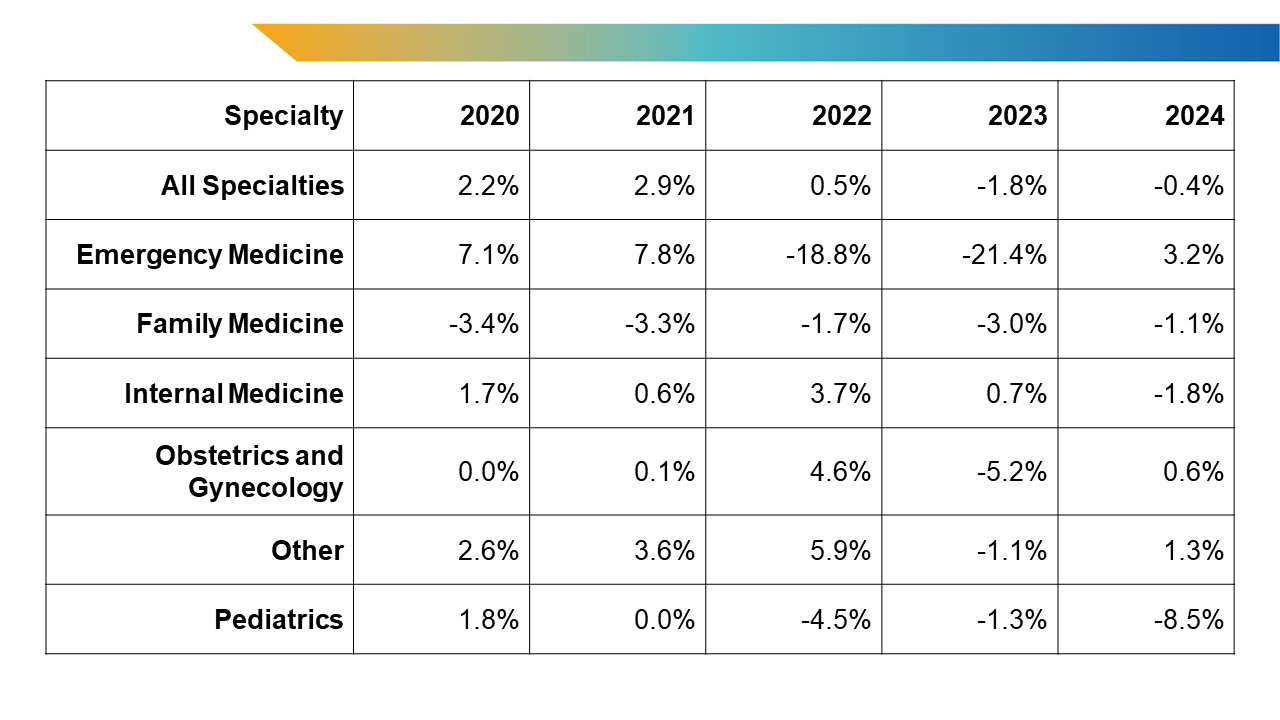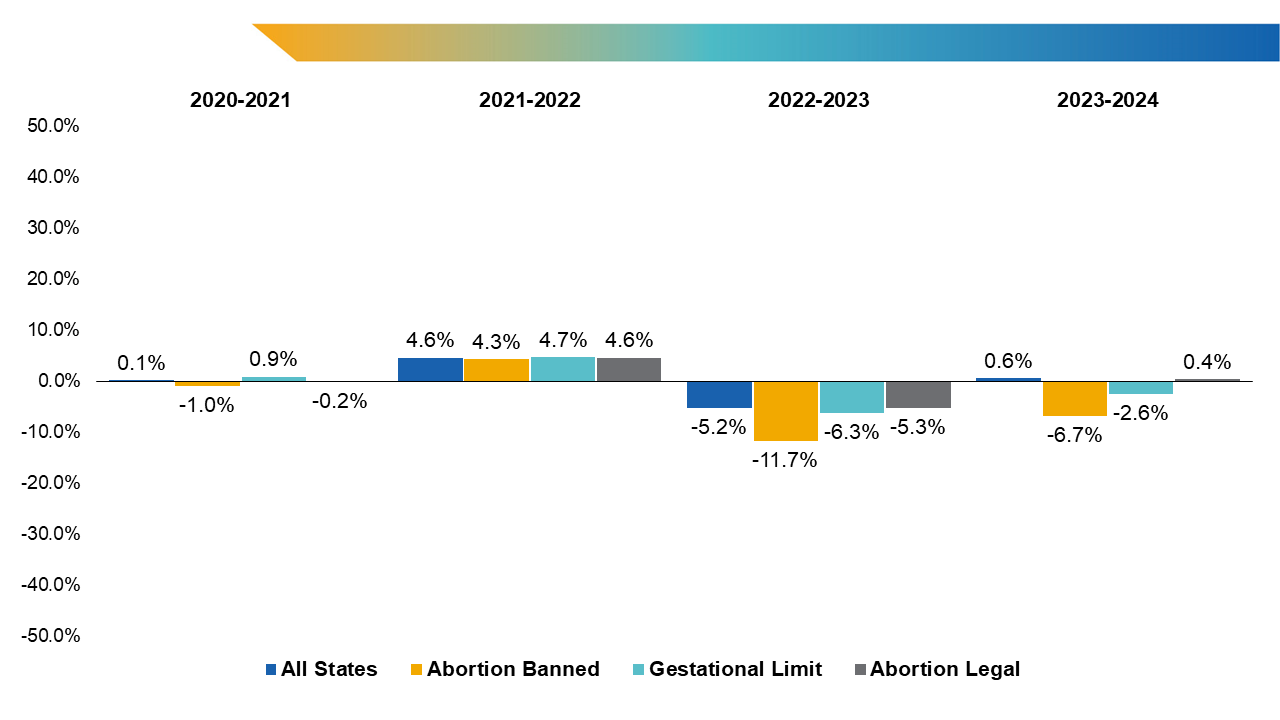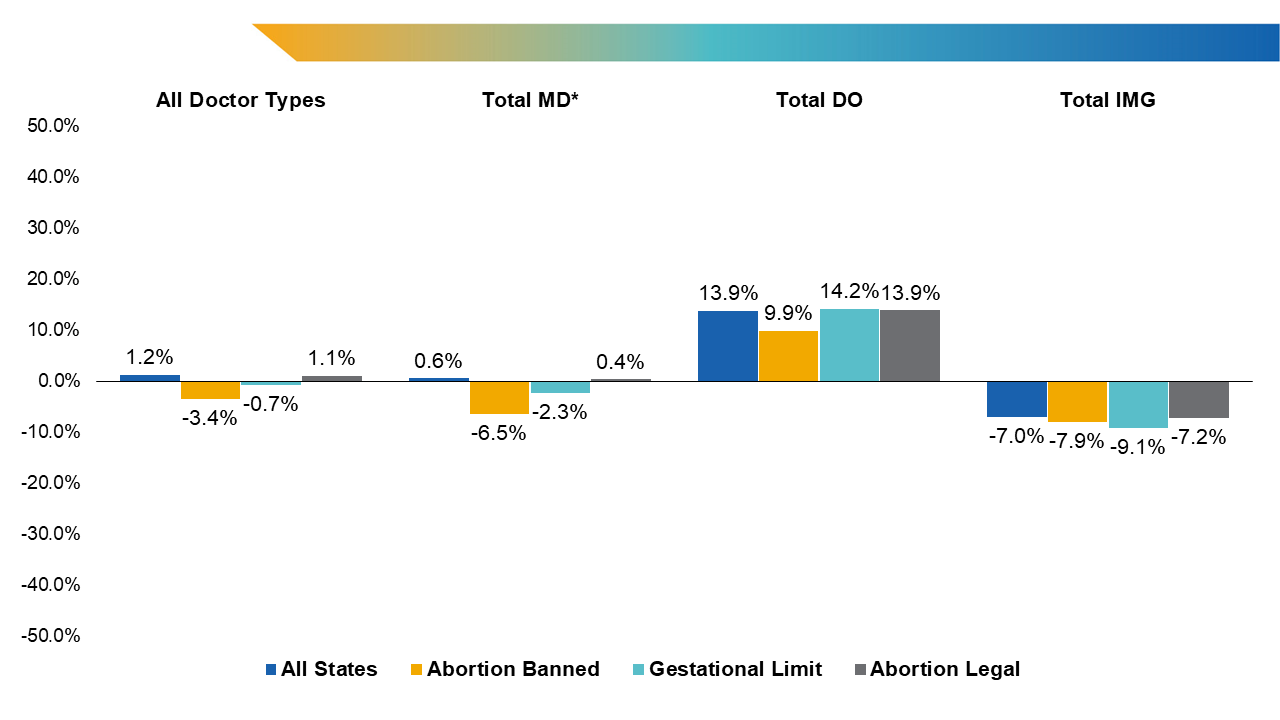A 2023 analysis by the AAMC Research and Action Institute found that fewer new graduates of U.S. medical schools applied to residency programs in states that banned or restricted access to abortion than to residency programs in states where abortion remained legal. That analysis was performed after the U.S. Supreme Court issued its decision on Dobbs v. Jackson Women’s Health Organizationin June 2022, immediately prior to the submission of residency applications through the Electronic Residency Application Service® (ERAS®) for the 2022-2023 application cycle. The ERAS program is a centralized online application service created and maintained by the AAMC as a resource for applicants, program directors, designated institutional officials, and deans of medical schools. The following analysis is an update of the 2023 data snapshot, Training Location Preferences of U.S. Medical School Graduates Post Dobbs v. Jackson Women’s Health.
The new data analysis finds continued reductions in applicants to residency programs located in states with abortion bans two years after the Dobbs decision (during the 2023-2024 application cycle). As of April 1, 2024, 14 states have enacted full bans on abortion (up from 13 in 20231 ). Because these policy decisions appear to affect where physicians plan to practice, state governments and health care leaders need to consider the potential impact of those decisions on the physician workforce. This analysis examines residency applicant and application data by separating states into three cohorts: those with abortion bans, those with gestational limits, and those without gestational limits or abortion bans. While the number of unique medical school graduates, referred to as “U.S. MD seniors,” who applied to residency programs declined slightly in 2023-2024 from the previous application cycle, states with complete abortion bans saw greater decreases in the number of U.S. MD senior applicants than states with gestational limits or no restrictions. Continued disproportionate decreases in the number of applicants to programs in states with limits or restrictions were observed across all specialties in aggregate.
- The AAMC Research and Action Institute’s 2024 analysis examined changes in the number of unique applicants using KFF’s state abortion-ban status as of Jan. 20, 2023. Since that date, and as of April 1, 2024, Wisconsin switched from being a state with an abortion ban to a state with gestational limits. Since 2023, both Indiana and North Dakota became states with abortion bans. Back to text ↑
In this analysis, and in the 2023 analysis, the authors chose to focus on U.S. MD seniors, who historically have the greatest chance of matching into specialties and programs of their choice compared with osteopathic physicians (DOs) and international medical graduate (IMG) applicants; U.S. MD seniors are likely to be most sensitive to practice and training restrictions in states with total abortion bans or gestational limits on abortion.2
- National Resident Matching Program. Advance Data Tables: 2024 Main Residency Match. https://www.nrmp.org/wp-content/uploads/2024/03/Advance-Data-Tables-2024.pdf. Accessed April 24, 2024. Back to text ↑
Compared to previous years, U.S. MD seniors submitted fewer applications per person in the 2023-2024 cycle. The reduction in applications per person resulted in applicants (on average) applying to programs across fewer states than in previous years, which should be considered when interpreting the figures below.
Despite a decrease of only 72 U.S. MD senior applicants this cycle compared to last year, the number of total applications submitted by all U.S. MD seniors decreased by over 100,000. The average state saw a 10.1% decline in U.S. MD senior applicants, but the change varied by state — ranging from a decrease of 19.3% to an increase of 30.3%. The reduction in applications per applicant has been a stated goal of the ERAS® program and residency program directors, yet a disproportionate decrease in applicants to programs in states with abortion bans is still observable.
For the second year in a row, decreases were observed in the total number of U.S. MD senior applicants to programs in states across ban status, with larger decreases in states with complete bans (Figure 1). Overall, the number of unique U.S. MD senior applicants to residencies in states with abortion bans decreased from the previous cycle by 4.2%, compared with a smaller decrease in states where abortions remained legal (0.6%).
States’ abortion-ban status may be correlated with program number and size, but these findings suggest that applicants may be responding to something independent of program size, particularly given two years of similar patterns. In other words, while states with more severe restrictions are often less populous (and have fewer residency programs) than other states, U.S. MD applicants may be selectively reducing their likelihood of applying to programs in states with more state-imposed restrictions on health care regardless of the number of available residency programs. The relative decrease in applicants to programs in states with abortion restrictions compared with the number of applicants to programs in states where abortion remains legal was also greater in 2024 than in 2023.




